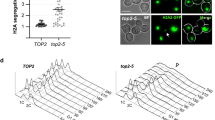Abstract.
Diplochromosomes, consisting of four chromatids lying side-by-side, instead of the normal two, are produced when cells go through two rounds of DNA replication without separation of chromatids. They are thus an indication of the failure of the normal chromosome separation mechanism. In the present experiments, induction of diplochromosomes by inhibitors of topoisomerase II (Topo II) was used to provide further evidence that Topo II is required for separation of daughter chromosomes. Actively growing cultures of CHO cells were treated with Colcemid, and separated into metaphase and interphase fractions, each of which was treated for 2 h with the Topo II inhibitor being tested. The cells were then cultivated in fresh medium without inhibitor for periods of between 18 and 44 h, and metaphase cells once again accumulated by treatment with Colcemid. Chromosome preparations were made in the standard way and stained with Giemsa. Up to 2,000 metaphases were counted from each culture, and the proportion with diplochromosomes calculated. At appropriate concentrations, the Topo II inhibitors etoposide and mitoxantrone induced substantial levels of metaphases with diplochromosomes in cultures that had been treated when the cells were in interphase (up to 30% and 11%, respectively). Amsacrine, however, only produced a smaller proportion (4.7%) of metaphases with diplochromosomes after a much longer culture period following treatment. All the inhibitors caused severe chromosome damage. When used to treat metaphase cells, mitoxantrone and amsacrine only induced diplochromosomes after prolonged culture, although a small number of diplochromosomes were seen after etoposide treatment and a shorter period of culture. Results with cells treated in metaphase might indicate that Topo II is, in fact, not required for anaphase chromosome separation, although it is clearly important for segregation of newly replicated DNA.
Similar content being viewed by others
Author information
Authors and Affiliations
Additional information
Received: 8 August 1998 / Accepted: 13 September 1998
Rights and permissions
About this article
Cite this article
Sumner, A. Induction of diplochromosomes in mammalian cells by inhibitors of topoisomerase II. Chromosoma 107, 486–490 (1998). https://doi.org/10.1007/s004120050333
Issue Date:
DOI: https://doi.org/10.1007/s004120050333



